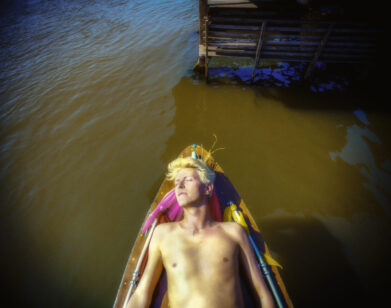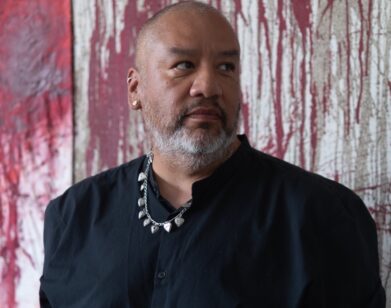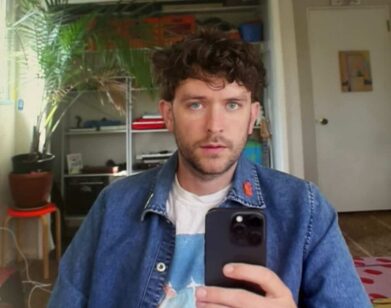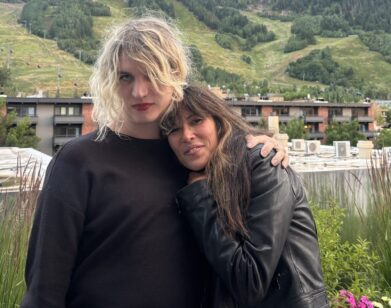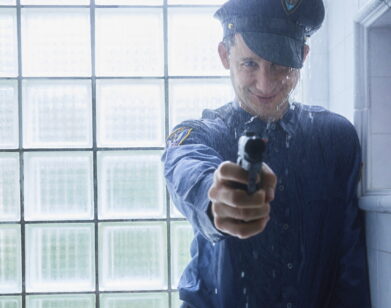Music to Your Eyes
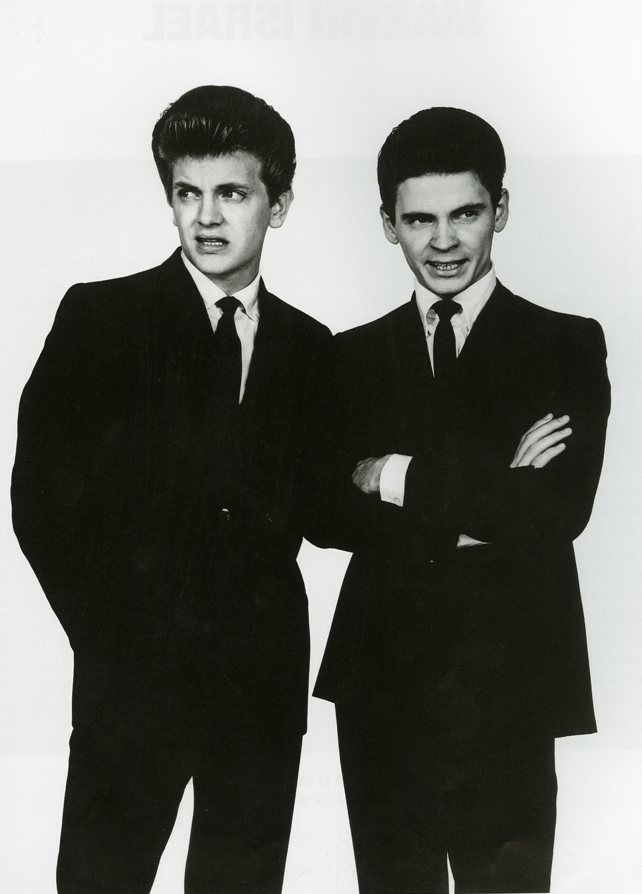
David Corio, Salt-n-Pepa at Radio City Music Hall, New York City, May 27, 1992
“Part of the story of the image of rock is censorship, and driving people crazy,” explains Gail Buckland, the photo historian behind the forthcoming book Who Shot Rock & Roll: A Photographic History, 1955-Present (Knopf). Another part of the story, according to Buckland, is quite literally about answering the question: Who shot rock & roll? She sets out for answers with an exhaustive tome and multi-sensory exhibition of the same name, which she’s curated for the Brooklyn Museum.
If the stories here can be called answers, there’s Philip Townsend’s tales about his photographs of the Rolling Stones in a literal gutter (they were trying perhaps a little too hard to change their nice-guy reputations); of how David Bowie learned to strike his pose in front of the editor of Sixteen magazine (awkwardly); and the strange censoring of a toilet on the cover of The Mamas and the Papas’ “If You Can Believe Your Eyes and Ears.”
The six-section exhibition is equally ambitious, with audio histories provided by many of the photographers, a special room meant to replicate Henry Diltz’s famed slideshow parties (where he’d gather all his famous friends and show reels of shots he’d snapped of them), and a special percussion accompaniment inspired by Debbie Harry. “We went out to dinner and she’s just hitting the table, getting a beat going and she says, ‘When I walk around an exhibition I just want to hear some good percussion,'” recalls Buckland. “So we have that. And Blondie is playing the opening.” Not a bad way to kickoff a rock show.
MICHAEL SLENSKE: You’ve written a number of photo books like Fox Talbot and The Invention of Photography, The Magic Image, and did the photo research for Harold Evans’ history The American Century. But where did this one start?
GAIL BUCKLAND: It was my friend Jonathan Mauder’s idea—not mine, because I’m certainly no expert in rock ‘n roll. He always loved Rolling Stone‘s book of photographs, to which there hasn’t been an update. I’ve been around long enough to remember when fashion was a stepchild and museums wouldn’t show fashion photographs because it was too commercial. Gradually, different genres are brought into the pantheon. So many of the images that shape our consciousness come from our teen years and young adulthood and we often don’t even know who took them.
SLENSKE: Were there any such definitive images for you?
BUCKLAND: I remember thinking immediately of Freewheelin’ Bob Dylan, and seeing Dylan and Suze Rotolo walking down that snowy street somewhere in New York. I wanted to get out of my teenage bedroom and go wherever they were going, and it turns out the man that took the photograph lives on the Upper West Side. He’s my neighbor. Henry Diltz, whose photograph of Tina Turner is on the cover, spent his life taking pictures of his friends—Crosby, Stills & Nash, The Eagles, Joni Mitchell. He said his whole career nobody spoke to him like I spoke to him because I came and I said, “I’d like to see you, what you’ve done.” He said, “What, Joni? What do you want to see?” I said, “No, I want to see you.”
SLENSKE: That was a common response? (LEFT: DETAIL OF THE ROLLING STONES AT THE ALTAMONT SPEEDWAY FREE FESTIVAL, CALIFORNIA, DECEMBER 6, 1969)
BUCKLAND: Every photographer was taken aback, because people have only been interested by who’s in the picture. I visited almost every photographer and went through their archives.
SLESNKE: So did the show come from the book or vice versa?
BUCKLAND: I had the idea for the book first, but almost immediately I mentioned it to Arnold Lehman, who is the director of the Brooklyn Museum. I think in terms of books because I’ve done 12, but I have to say it’s been a total collaboration with the Brooklyn Museum. And it is not easy to work with rock ‘n’ roll photographers.
SLENSKE: Why is that?
BUCKLAND: First of all, they’re not used to exhibiting in a museum, and I wanted vintage prints and many of them think that because they’re associated with galleries that a new big digital print looks better. I didn’t want prints on the wall that are competing with posters, you know, because sometimes they blow it up to an ugly gray mush.
SLESNKE: There are also a fair amount of art photographers in the book as well.
BUCKLAND: These are people I haven’t had contact with directly. Andreas Gursky was in Germany, and Ryan McGinley was shooting a project all this year. But it’s still fascinating. McGinley, I can’t even remember how many Morrissey concerts he’s gone too. And those pictures have enormous integrity; they’re so much about being caught emotionally and spiritually in a wave of people. With Gursky, as I say in the book, he’s the perfect photographer for Madonna. Not Madonna the person, but Madonna in the marketplace, because so much of Gursky’s work is about the industrial complex.
SLENSKE: It was interesting to read the piece about Kevin Cummins taking pictures of Ian Curtis and how staged everything was—how he wasn’t really as dark as the image of him depicted. It was like showing the reader the wizard. (LEFT: THE EVERLY BROTHERS: PHIL AND DON EVERLY, LAS VEGAS, NEVADA, JANURY 17, 1961)
BUCKLAND: Well, [Cummins] doesn’t like Anton Corbijn’s film, but Kevin was giving a talk in Manchester and a young woman came up to him afterward and asked, “You said that you have lots of photographs of Ian Curtis smiling and laughing but you never published any of those. Do you think it might be possible to see [them]?” And Kevin, kind of grumpily says, “Why?” And she says, “Well, I’m his daughter and I’ve never seen a photo of my father smiling.” She was a baby when he killed himself and Kevin kind of did a double take because he realized how much he had contributed to the myth.
Philip Townsend was all of 23 when he was asked to take the first photographs of the Rolling Stones and they didn’t even have a record contract. Phil was told to make them look mean and nasty and they were really just sweet guys. So one of the sections in the exhibition there’s a section called “Starting Out” and you learn that some of them haven’t learned the pose yet.
SLENSKE: Pink Floyd come off nicely here.
BUCKLAND: They are very awkward when they’re photographed, which is why they commissioned Hypnosis to come up with these fantastic album covers. They hated having themselves on the cover.
SLENSKE: Not everyone learns the pose required of them, I guess.
BUCKLAND: There’s a photograph in the exhibition I wasn’t allowed to publish because they didn’t know who the copyright holder was. It’s the Rolling Stones surrounding a big, floppy, cuddly dog. Andrew Loog Oldham came up with this phrase “Would you let your daughter go out with a Rolling Stone?” And that snapshot of them wasn’t supposed to be released because they just look too sweet.
SLENSKE: So intentional provocation is obviously a big part of this show?
BUCKLAND: I talk about Elvis being cropped below the waist, but there’s still a lot of hesitance. There’s a picture of Mick Jagger on stage with a microphone tucked into his pants. There are certain people who wanted to run it as a poster in a public spot; others didn’t because it’s too sexy.
There’s a photo of Marianne Faithfull in the book by Gerard Mankewitz. They were friends and they were both 18 years old. She’s sitting in a pub and she needed an album cover for Decca and she has high socks and Mary Jane shoes and this come hither look. The reason Decca rejected it was because there’s two men reflected in the mirror that look like they could be leering at a teenage girl. What’s always funny in the history of music photography is the photograph that replaces the real famous one are these totally innocuous one that nobody remembers.
There’s a photograph Guy Webster took of The Mamas and The Papas, and they were all on LSD so they got as far as the bathtub. Webster tells me he said, “Okay, if they can’t get outside I’ll just take a picture of them here.” So he takes a picture of them standing in the bathtub. They submitted it and it became an album cover, but then too many stores wouldn’t carry it because it showed a toilet. So they had to put a sticker over the toilet that said, “Included is California Dreamin.'”
SLENSKE: What’s the experience you wanted create at the museum?
BUCKLAND: Exhibitions are about moving through space. It’s organized by sections—”Behind The Scenes”; “Portraits”; “Starting Out”; “Fans and Crowds”; there’s subsections on Bob Dylan, and Jimmy Hendrix and Grace Jones; there’s “Constructing An Image.”
SLENSKE: Anything else?
BUCKLAND: In the exhibition you’re going to hear the photographer’s own voices talking about the pictures, not me, not the museum director. They’ll talk about what was going on and why they took the pictures. We have some music videos from Mick Rock and early David Bowie. There’ll be ambient sound, and Jean Paul Goude edited a special video for us from his footage. Also, Chris Stein composed percussion especially for the exhibition, so if you want to go around and just hear some good rhythm you can listen to it. Actually it was Debbie Harry’s idea.
SLENSKE: So there’s a soundtrack to the exhibition?
BUCKLAND: Yeah, if you want it.
Who Shot Rock & Roll: A Photographic History, 1955-Present (Knopf) is in bookstores October 22; opening at the Brooklyn Museum October 30–January 31, 2010.


